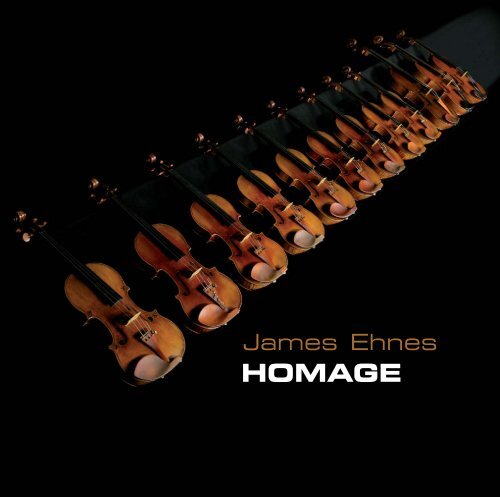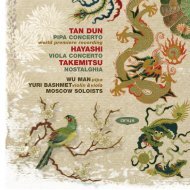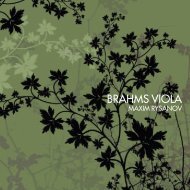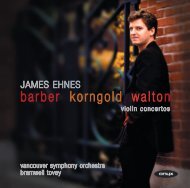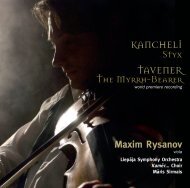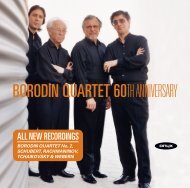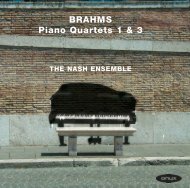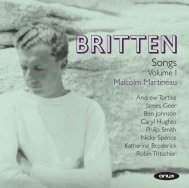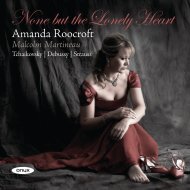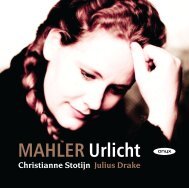HOMAGE - Onyx Classics
HOMAGE - Onyx Classics
HOMAGE - Onyx Classics
- No tags were found...
Create successful ePaper yourself
Turn your PDF publications into a flip-book with our unique Google optimized e-Paper software.
<strong>HOMAGE</strong>ViolinsANTONIO BAZZINI1 La Ronde des Lutins 4.54Antonio Stradivari, 1715 ‘Marsick’MANUEL DE FALLA (arr. Paul Kochanski)Suite populaire espagnole2 I El paño moruno 2.14Giuseppe Guarneri ‘del Gesù’, 1737 ‘King Joseph’3 II Nana 2.18Antonio Stradivari, 1733 ‘Sassoon’4 III Canción 1.26Antonio Stradivari, 1719 ‘Duke of Alba’5 IV Polo 1.20Giuseppe Guarneri ‘del Gesù’, 1742 ‘Lord Wilton’6 V Asturiana 2.00Antonio Stradivari, 1709 ‘La Pucelle’7 VI Jota 3.01Antonio Stradivari, 1715 ‘Baron Knoop’EDWARD ELGAR8 La Capricieuse 4.13Pietro Guarneri (Peter of Mantua), 1698 ‘Shapiro’CYRIL SCOTT (arr. Fritz Kreisler)9 Lotus Land 5.03Giuseppe Guarneri ‘del Gesù’, 1737 ‘King Joseph’GRIGORAŞ DINICU (arr. Jascha Heifetz)10 Hora staccato 1.59Antonio Stradivari, 1713 ‘Baron d’Assignies’
<strong>HOMAGE</strong>As music has developed through history, so have musical instruments. The instrumental families ofstrings, winds and percussion have remained constant, but the instruments themselves havecontinuously evolved. Today’s flutes have little relation to the flutes played by the ancient Greeks,and Bach would have been amazed by today’s concert grand piano. But string instruments are anexception: the most coveted violins, violas and cellos are those that were made hundreds of yearsago, in a small area of northern Italy, by a handful of legendary makers.Our finest string instruments possess a perfect combination of tonal beauty, range of colour, clarity,and projection. It is not uncommon to find an instrument with one or even two of these traits inabundance, but to find all of these elements in the same instrument is rare indeed. The makers ofthe instruments featured in this recording created violins and violas that have never been surpassed.It remains a mystery why string instrument making reached its peak at this particular period inhistory. Perhaps the only reasonable explanation is that making string instruments is not just a craft,but also an art form. Like many art forms, violin-making had a ‘golden age’ where brilliant artistsliving in close proximity during a time of high market demand inspired one another to create worksof unequalled greatness.Over the centuries, the instruments of this era have been dispersed across the globe. Butperiodically there have been individuals who have compiled important collections of thesemagnificent violins, violas and cellos, providing a unique opportunity to see them within a context,and allowing players not just to appreciate them individually, but to compare and contrast. Dr DavidFulton has amassed one of history’s finest private collections, containing many of the world’s mostrenowned stringed instruments. This recording is the result of his vision to create an historicaldocument of these instruments at this point in time.The violin took on its present form in the 1500s. Andrea Amati (ca.1505–ca.1578) is most oftenconsidered to be the father of the ‘modern’ violin. Amati worked in Cremona, a city in the Po valleyin what is now northern Italy. Though only a handful of his instruments survive today, it was due tohis success that Cremona became the centre for string instrument making in Italy and home to manyother eminent makers, including members of the Guarneri family, Antonio Stradivari, Carlo Bergonzi,and Amati’s own descendants: Hieronymus, Antonio, Nicolò and Hieronymus II.
these instruments and their suitability for concert use. It has become a common notion thatStradivari’s pre-1700 violins are not ideal ‘concert’ instruments, a belief that is clearly shown to beincorrect when one has had the opportunity to hear some of the greatest violins from this period.Violins from Stradivari’s ‘long’ period (approximately 1692–99 with some notable exceptions) areseen by some to have been an unsuccessful experiment, but some of these violins are among thegreat concert instruments, notable for incredible projection and bold, clear tone. Similarly, there isa perceived superiority to the work of ‘del Gesù’ after 1740. While it is true that many of his mostexceptional violins do come from this period, it cannot be reasonably argued that they are truly ona higher level tonally than some of his finest earlier examples. As for one maker’s ‘superiority’ overthe other, this is an unanswerable question. Different instruments will appeal to different types ofplayers. It is my opinion that the best violins of each maker have certain advantages over those ofthe other depending on the repertoire, the acoustic in which it is being played, and what the playeris trying to achieve musically. Ultimately, these instruments are tools of expression, and the greatexamples by both makers are virtually limitless in their capabilities; any shortcomings in theperformances coming from these instruments are the fault of the player, not the maker.1698 Pietro Guarneri (Peter of Mantua) ‘Shapiro’The instruments of Pietro Guarneri of Mantua (1655–1720) are exceedingly rare. He was a musicianas well as a maker, and it is thought that this double career is one of the reasons that he crafted sofew instruments (there are 42 known violins, one tenor viol and one cello). This violin is of particularinterest due to its beautifully inlaid fleur-de-lys in each corner on both the front and back.1709 Antonio Stradivari ‘La Pucelle’This celebrated violin is one of the best-preserved Stradivaris in existence. Its nickname came aboutwhen the great violin-maker, dealer, and restorer J.B. Vuillaume first saw the violin around 1850 andexclaimed that it was ‘comme une pucelle!’ (‘like a virgin!’). In other words, the violin had never beenopened since leaving Stradivari’s hands. Vuillaume modernised the instrument, replacing the neck,bassbar, and fittings. The violin has not had any alterations or repairs of any kind done since thistime. It still retains Vuillaume’s pegs and tailpiece, the latter of which is beautifully carved with theimage of Jeanne d’Arc (known in France as ‘la Pucelle d’Orléans’). This violin has never previouslybeen heard on a recording.
1713 Antonio Stradivari ‘Baron d’Assignies’This violin is remarkable for its bright, powerful tone and its very fresh state of preservation. Itshows little evidence of hard use, and was, in fact, unknown to modern experts until 1955. DavidFulton is only the third known owner of this violin. One notable aspect of its construction is thethickness of its top; at 2.9 mm, it is a quarter-millimetre thicker than that of any other knownStradivari violin.1715 Antonio Stradivari ‘Marsick’I have had the great pleasure of using this violin as my concert instrument since September of 1999.Though the name of the Belgian violinist Martin-Pierre Marsick is attached to this instrument, heonly owned it for one year, acquiring it in 1879 and selling it in 1880. Ownership can be traced fromaround 1870 through the early years of the 20 th century. At some point thereafter, the violin wentto the Soviet Union, where it remained until being obtained by the British dealer Peter Biddulpharound 1990. There is another ‘Marsick’ Strad, an example from 1705 that later became the concertinstrument of David Oistrakh. There is also evidence that Marsick had a 1726 Strad for some timearound the turn of the 20 th century.1715 Antonio Stradivari ‘Baron Knoop’One of Stradivari’s most famous instruments, this violin takes its name from the great collectorBaron Johann Knoop (1846–1918), who had one of the great string instrument collections of all time.According to the great British dealer Alfred Hill, this violin was the Baron’s favorite. It is referred toas the ‘Bevan’ (a later owner) in the Hill book on Stradivari, and is specially mentioned to be of ‘thefirst rank’. Jascha Heifetz used this violin between December 1936 and January 1938.1719 Antonio Stradivari ‘Duke of Alba’Ownership of this instrument can be traced back to the year 1788, when it was entrusted by theDuke of Alba to Vicenzo Ascensio of Madrid for repairs (there is an inscription by Ascensio stillvisible on the label). Like so many great violins, it ended up with the French dealer Vuillaume around1850, and was subsequently sold to the family of Wilhelm von Booth, a German nobleman, withwhose family it remained until 1911. While in the possession of Otto Booth (the son of Wilhelm)around the turn of the 20 th century, the violin resided in South Africa, and was, according to ArthurHill, the only Stradivari in that part of the world at that time.
1733 Antonio Stradivari ‘Sassoon’This typical example of Stradivari’s last working period is in a very fresh state of preservation, havingspent most of its known history in the hands of amateur players and collectors. The violin waspurchased in 1892 by the Roussy family (the proprietors of Nestle’s Milk) and remained theirproperty for the next 75 years. For much of this time it seems highly likely that the violin wasvirtually not played at all; from 1924 until 1966 it resided in a vault in London. As is typical withStradivari’s late instruments, the maple of the back, sides and scroll is quite plain in figure, and thevarnish is of a somewhat more brownish hue than that used during his ‘golden period’.1737 Giuseppe Guarneri ‘del Gesù’ ‘King Joseph’This violin is one of the most superb examples of del Gesù’s late-middle period, combining greatbeauty of craftsmanship with stunning tone. Its back is in one piece of slab-cut maple, a somewhatunusual feature in the work of ‘del Gesù’. Reportedly the first ‘del Gesù’ violin to travel to the US, ithas often been considered to be his greatest masterpiece – hence its nickname. Interestingly, it seemsthat this violin was formerly known as the ‘King’ Joseph Guarneri, but is now known as the ‘KingJoseph’ Guarneri – perhaps to avoid confusion with a 1735 ‘del Gesù’ that is also known as the ‘King’.1742 Giuseppe Guarneri ‘del Gesù’ ‘Lord Wilton’This famous violin was the final concert instrument of Yehudi Menuhin, who acquired it in 1978,though he had performed on it as early as the 1940s. Its condition is virtually flawless, and it hasbeen recognised for many generations as one of the most tonally outstanding of ‘del Gesù’ violins.It was a particular favourite of the Hill family, who featured it prominently in their 1931 book aboutthe Guarneri family of makers.ca. 1560 Gasparo Bertolotti (Gasparo da Salò)While Andrea Amati was developing the modern violin in Cremona, Gasparo da Salò (1540–1609), asGasparo Bertolotti is commonly known, was making rugged, yet tonally outstanding instruments inBrescia. Violas made by Gasparo da Salò are coveted for their deep, resonant tone, though theirlarge size makes them difficult to play for violists without long arms and fingers. Sadly, many of hisinstruments have been cut down in size over the years in order to be more ‘practical’ for smallerplayers (this was also the fate of most of Stradivari’s early cellos, which were also built on what isnow considered an abnormally large pattern). This instrument retains its original dimensions.Though body length of violas is by no means standardised, this instrument’s body length of17” 5/8ths is over an inch longer than what is generally considered a ‘full-sized’ viola.
1676 Andrea Guarneri ‘Count Vitale, ex Landau’One of the most acclaimed violas in existence, this is one of only five known violas by this maker.Having been in the hands of amateurs and collectors for 200 years, it is in a practically perfect stateof preservation. It is a rare example of a Cremonese instrument that retains its original neck, thoughit was reset by the famous maker Carlo Mantegazza many years ago for modern usage. A referenceto this instrument is found in the 1 April 1816 diary entry of the collector Count Cozio di Salabue,placing ownership with Count Vitale of Milan, whose initials (S.V.) are branded into the button onthe back. Subsequently in the possession of Sir William Curtis (a Member of Parliament for the Cityof London from 1790 to 1826, and Lord Mayor in 1795), it was reportedly used in chamber-musicreadings with King George IV.1793 Giuseppe Guadagnini ‘Rolla’Giuseppe Guadagnini (1753–1805) was the son of the distinguished maker J.B. Guadagnini. Like hisfather, he worked in various different cities during his lifetime; this viola was made in Parma. It isbuilt on relatively small dimensions, the length of the body being a mere 15 5/8”.The pairing of a stringed instrument with the right bow is crucial. It is remarkable what an enormousdifference a particular bow can make to the tone of a violin or viola, and not something that is easilyexplained. A great bow can add depth to the tone of a bright instrument, brighten the tone of amellow instrument, or provide extra clarity and power. However, the pairing of a great bow with agreat violin does not guarantee good results. The wrong combination can stifle the tone of aninstrument or exaggerate a particular quality of its tone past the point of desirability.The bows used on this recording were made by the two most illustrious names in bow-making:François-Xavier Tourte (1747–1835) and Dominique Peccatte (1810–1874). David Fulton possesses oneof the world’s great bow collections, and I spent many hours comparing different bows on differentinstruments, trying to find the perfect match. For the nine violins, I used four different bows: aTourte for both ‘del Gesù’ violins, a different Tourte for the ‘Baron Knoop’, ‘Pucelle’, and ‘Duke ofAlba’ Stradivaris, yet another Tourte, an early example, for the ‘Sassoon’ Stradivari, and a Peccattefor the ‘Marsick’ and ‘Baron d’Assignies’ Stradivaris and the Pietro Guarneri. I used a different bowfor each of the violas: Tourtes for the Guarneri and the Gasparo da Salò, and a Peccatte for theGuadagnini.
Choosing repertoire for this project was a special challenge. It was important to me that therecording would be able to stand alone in terms of musical merit, and that it would present aninteresting and enjoyable musical programme regardless of the fact that it features so manydifferent instruments. I also wanted to choose repertoire that highlights special qualities of theindividual violins and violas. Owing to my friendship with David Fulton, I had been able to get toknow each of these violins and violas quite well in the years leading up to the recording. All of theselections on this recording were chosen with a particular instrument in mind, with the idea ofdisplaying some tonal quality of the instrument in question.The excerpts from Bruch’s Scottish Fantasy and Berlioz’s Harold in Italy on the comparison tracks arethose which I have used over the years to try out violins and violas. Covering the entire range of theinstrument, these excerpts provide a quick way of exploring the tonal possibilities of a particularviolin or viola. The difference in tone between instruments is often very subtle indeed, and, ofcourse, the personality of the player will be the most defining element of the sound produced onany violin or viola. Still, I hope the listener will find that each of these magnificent instruments hasa unique, personal voice.James Ehnes
HOMMAGEL’évolution des instruments de musique s’est faite parallèlement à celle de la musique elle-même àtravers l’histoire. Les familles instrumentales – cordes, vents et percussions – sont restéesconstantes, mais les instruments eux-mêmes ont continuellement évolué. Les flûtes actuelles n’ontpas grande relation avec les flûtes jouées par les Grecs anciens, et Bach aurait été étonné par lepiano de concert d’aujourd’hui. Mais les instruments à cordes sont une exception : les instrumentsles plus convoités sont ceux qui ont été faits il y a plusieurs centaines d’années, dans une petiterégion du nord de l’Italie, par une poignée de luthiers légendaires.Nos meilleurs instruments à cordes possèdent une combinaison parfaite de beauté sonore,d’étendue de couleurs, de clarté et de puissance. Il n’est pas rare de voir un instrument qui possèdeune ou deux de ses qualités, mais il est exceptionnel que tous ces éléments soient réunis dans lemême instrument. Les artisans qui ont fait les instruments présentés dans cet enregistrement ontsigné des violons et des altos qui n’ont jamais été surpassés. Pourquoi les instruments à cordesont-ils atteint leur apogée à cette époque particulière ? Le mystère demeure. Sans doute la seuleexplication raisonnable est-elle que la lutherie n’est pas seulement un artisanat, mais une formed’art. Comme beaucoup de formes d’art, la lutherie a eu son « âge d’or », où de brillants artistes,vivant à proximité, à un moment de forte demande, s’inspirèrent l’un l’autre pour créer des œuvresd’une grandeur sans égale.Au fil des siècles, les instruments de cette époque ont été dispersés à travers le monde. Mais,régulièrement, des particuliers ont réuni d’importantes collections de ces magnifiques violons, altos,violoncelles, offrant l’occasion unique de les découvrir dans un contexte, et permettant auxmusiciens non seulement de les apprécier individuellement, mais de les comparer et de les opposer.David Fulton a rassemblé l’une des plus belles collections privées, contenant bon nombre desinstruments à cordes les plus renommés au monde. Cet enregistrement est le fruit de sa volonté decréer aujourd’hui un document historique sur ces instruments.Le violon a trouvé sa forme actuelle dans les années 1500. On considère souvent Andrea Amati(v.1505–v.1578) comme le père du violon « moderne ». Amati travailla à Crémone, ville de la valléedu Pô dans le nord de l’Italie actuelle. Bien que seuls quelques-uns de ses instruments surviventaujourd’hui, c’est grâce à son succès que Crémone est devenue la capitale de la lutherie en Italie et
la patrie de nombre d’éminents luthiers, dont les membres de la famille Guarneri, Antonio Stradivari,Carlo Bergonzi et les descendants d’Amati lui-même : Hieronymus, Antonio, Nicolò et Hieronymus II.Dès le début des années 1700, la lutherie était à son apogée. Le plus grand luthier de l’époque futincontestablement Antonio Stradivari (1644–1737), dit Stradivari. La plus ancienne étiquette connuede Stradivari affirme qu’il fut l’élève de Nicolò Amati, encore que beaucoup d’experts pensentaujourd’hui que c’était une invention hardie du jeune luthier pour se rendre plus crédible. Il ne faitcependant aucun doute que le jeune Stradivari, comme tous ses contemporains, fut fortementinfluencé par Amati. Dès la trentaine, il commença à signer des instruments pour certaines desfamilles les plus renommées et les plus fortunées d’Europe, notamment à la cour d’Espagne et pourla famille Médicis à Florence. Son « âge d’or » commença au début des années 1700 (se situantapproximativement entre 1709 et 1720, encore que certains experts le fassent remonter à 1703, voireà 1700) ; ce sont les instruments de cette période qui ont défini le prototype du violon. Ses violonsde ces années parviennent à une synthèse parfaite entre perfection sonore et beauté de conception,et sont recherchés tant par les interprètes que par les collectionneurs.Giuseppe Guarneri « del Gesù » (1698–1745) fut le plus grand facteur de l’une des célèbres familles deluthiers. Son grand-père Andrea Guarneri (1626–1698) débuta comme apprenti de Nicolò Amati etproduisit de nombreux instruments magnifiques, dont l’alto présenté dans cet enregistrement. Les deuxfils d’Andrea, Giuseppe (« filius Andrea », « fils d’André ») et Pietro (« Pierre de Mantoue »), furentégalement d’excellents luthiers, dont les violons sont généralement même considérés comme supérieursà ceux de leur père. Giuseppe « filius Andrea » eut lui aussi deux fils : Pietro (« Pierre de Venise ») etGiuseppe, qu’on surnomme aujourd’hui « del Gesù », en raison de la présence des caractères IHS(abréviation grecque pour Jésus) et d’une croix sur ses étiquettes. « Del Gesù » ne connut ni la renomméeni la fortune de Stradivari de son vivant, mais il est désormais considéré comme son égal. Pendant queStradivari faisait des instruments pour bon nombre des Européens les plus riches et les plus influents,« del Gesù » destinait ses violons, pense-t-on, aux musiciens locaux. Cela pourrait expliquer dans unecertaine mesure le nombre relativement restreint d’instruments qui survivent ; on estime qu’il resteenviron cent quarante violons, et un seul violoncelle (portant l’étiquette de son père, mais révélantclairement le travail du jeune « del Gesù »). En revanche, on connaît plus de six cents Stradivari.On a souvent comparé les violons de Stradivari et de Guarneri « del Gesù ». Bon nombre de grandsviolonistes ont eu plaisir à utiliser des instruments des deux facteurs (Henryk Wieniawski, FritzKreisler, Jascha Heifetz, Yehudi Menuhin, Arthur Grumiaux, Itzhak Perlman), mais beaucoup d’autres
sont restés fidèles toute leur vie à l’un ou à l’autre. C’est le légendaire Niccolò Paganini qui apportaaux instruments de « del Gesù » la reconnaissance qu’ils méritaient lorsqu’il fit d’un « del Gesù » de1742 son principal instrument de concert, même s’il possédait aussi et jouait des Stradivari. Il y abeaucoup d’idées fausses sur ces instruments et sur leur adéquation au concert. On pense souventque les Stradivari d’avant 1700 ne sont pas des instruments de « concert » idéals – idéemanifestement démentie pour peu qu’on ait l’occasion d’entendre certains des plus grands violonsde cette période. D’aucuns considèrent les violons de la période « longue » de Stradivari (1692–1699,environ, avec certaines exceptions notables) comme une expérience infructueuse, alors que certainsde ces violons sont parmi les plus grands instruments de concert, remarquables pour leur incroyablesonorité pénétrante et leur timbre clair et net. De même, on prête une supériorité aux instrumentsde « del Gesù » d’après 1740. S’il est vrai que la plupart de ses violons exceptionnels proviennent decette période, on ne peut raisonnablement affirmer qu’ils sont vraiment d’un niveau supérieur, surle plan sonore, à certains de ses meilleurs violons antérieurs. Quant à la « supériorité » de l’un desluthiers sur l’autre, c’est une question qui n’a pas de réponse. Différents types de musiciensapprécieront différents instruments. À mon avis, les meilleurs violons de chaque facteur ont certainsavantages sur ceux de l’autre, suivant le répertoire, l’acoustique dans laquelle ils sont joués, et ceque l’interprète essaie de faire musicalement. En fin de compte, ces instruments sont des outilsexpressifs, et les grands exemples des deux luthiers sont pratiquement sans limites dans leurscapacités ; toutes les insuffisances dans les interprétations données sur ces instruments sont la fautedu musicien, et non du luthier.1698 Pietro Guarneri (Pierre de Mantoue) « Shapiro »Les instruments de Pietro Guarneri de Mantoue (1655–1720) sont extrêmement rares. Lui-même étaità la fois musicien et luthier, et l’on pense que cette double carrière est l’une des raisons pourlesquelles il fit si peu d’instruments (on connaît quarante-deux violons, une viole ténor et unvioloncelle). Ce violon est particulièrement intéressant du fait de sa belle fleur de lys marquetéedans chaque coin, aussi bien devant qu’au dos.1709 Antonio Stradivari « La Pucelle »Ce célèbre violon est l’un des Strad les mieux conservés qu’on connaisse. Son surnom lui vint lorsquele grand luthier, marchand et restaurateur J.B. Vuillaume vit le violon pour la première fois vers 1850et s’exclama qu’il était « comme une pucelle ! » Autrement dit, le violon n’avait jamais été ouvertdepuis qu’il avait quitté les mains de Stradivari. Vuillaume a modernisé l’instrument, remplaçant le
manche, la barre et la garniture. Le violon n’a pas subi de modifications ni de réparations depuiscette époque. Il conserve toujours les chevilles et le cordier de Vuillaume, ce dernier étant sculptéd’une belle effigie de Jeanne d’Arc (« la Pucelle d’Orléans »). Ce violon n’a jusqu’à maintenant jamaisété enregistré.1713 Antonio Stradivari « Baron d’Assignies »Ce violon est remarquable pour sa sonorité brillante et puissante, et pour la fraîcheur de son état deconservation. Il ne semble guère avoir été très utilisé et était inconnu des experts modernes jusqu’en1955. David Fulton n’en est que le troisième propriétaire connu. L’un des aspects remarquables de safacture est l’épaisseur de sa table, 2,9 mm, soit un quart de millimètre de plus que tout autre violonconnu de Stradivari.1715 Antonio Stradivari « Marsick »J’ai eu le grand plaisir d’utiliser ce violon comme instrument de concert depuis septembre 1999. Bienque le nom du violoniste belge Martin-Pierre Marsick soit attaché à cet instrument, il ne lui aappartenu que pendant un an (1879–1880). On peut retracer ses propriétaires d’environ 1870jusqu’aux premières années du XX e siècle. À un certain moment ensuite, le violon partit pour l’Unionsoviétique, où il resta jusqu’à ce que le marchand britannique Peter Biddulph l’acquière vers 1990. Ilexiste un autre Strad « Marsick » de 1705, qui fut ensuite l’instrument de concert de David Oïstrakh.Il semble également que Marsick ait eu un Strad de 1726 pendant quelque temps au tournant duXX e siècle.1715 Antonio Stradivari « Baron Knoop »Ce violon, l’un des instruments les plus célèbres de Stradivari, doit son nom au grand collectionneurque fut le baron Johann Knoop (1846–1918), qui possédait l’une des plus grands collectionsd’instruments à cordes de tous les temps. D’après le grand marchand britannique Alfred Hill, ceviolon était le préféré du baron. Il est baptisé « Bevan » (propriétaire ultérieur) dans le livre de Hillsur Stradivari, spécialement cité comme un instrument « de premier ordre ». Jascha Heifetz utilisa ceviolon entre décembre 1936 et janvier 1938.1719 Antonio Stradivari « Duc d’Albe »La provenance de cet instrument peut être retracée jusqu’en 1788, année où il fut confié par le ducd’Albe à Vicenzo Ascensio de Madrid pour réparation (une inscription d’Ascensio est encore visiblesur l’étiquette). Comme tant de grands violons, il se retrouva chez le marchand français Vuillaume
Violinist James Ehnes is widely considered one of the most dynamic and exciting performers inclassical music. He has performed in over 25 countries on five continents, appearing with many ofthe world’s most well-known orchestras and conductors.Ehnes’s extensive discography of over 20 recordings features repertoire ranging from Bach violinsonatas to John Adams’s Road Movies. His recordings have been honoured with many internationalawards and prizes, including a Grammy, a Gramophone and five Juno awards.Born in 1976 in Brandon, Manitoba, Canada, he began violin studies at the age of four, and at ninebecame a protégé of the noted Canadian violinist Francis Chaplin. For several summers he studiedwith Sally Thomas at the Meadowmount School of Music, continuing his studies with her in 1993 atthe Juilliard School. He graduated from Julliard in 1997, winning the Peter Mennin Prize forOutstanding Achievement and Leadership in Music. In October 2005, James was honoured byBrandon University with a Doctor of Music degree (honoris causa) and in July 2007 he became theyoungest person ever elected as a Fellow to the Royal Society of Canada.James Ehnes plays the ‘Ex Marsick’ Stradivari of 1715 and gratefully acknowledges its extended loanfrom the Fulton Collection. He currently lives in Bradenton, Florida with his wife Kate.Le violoniste James Ehnes est considéré par beaucoup comme une des plus dynamiques etpassionnantes célébrités mondiales dans le domaine de la musique classique. Il s’est produit dansplus de 25 pays sur cinq continents, avec pour ainsi dire tous les orchestres et les chefs les plusréputés.La vaste discographie de James Ehnes de plus de 20 disques s’échelonne, pour le répertoire, dessonates pour violon de Bach aux Road Movies de John Adams. Ses enregistrements se sont distinguéspar des prix internationaux, incluant les prix Grammy, Gramophone et cinq prix Juno.Né à Brandon (Manitoba), au Canada, en 1976, il commence à étudier le violon à l’âge de quatre ans ;à neuf ans, il devient l’élève du célèbre violoniste canadien Francis Chaplin. Il poursuit ses étudesavec Sally Thomas à la Meadowmount School of Music et à la Juilliard School et, après avoir obtenuson diplôme en 1997, il remporte le prix Peter Mennin pour une réussite et une prééminenceexceptionnelles dans le domaine de la musique. Il a obtenu la prestigieuse bourse de carrière AveryFisher, est le récipiendaire d’un doctorat honorifique de l’Université de Brandon et, en 2007, il devintla plus jeune personne à être élue « fellow » de la Société royale du Canada.James Ehnes joue sur un Stradivari « Ex Marsick » de 1715, et tient à exprimer sa profondereconnaissance à la Fulton Collection pour le prêt à long terme de cet instrument.www.jamesehnes.com
Born in Laredo, Texas in 1964, Eduard Laurel began his musical studies on the trumpet at the age ofeight, and his piano studies at age ten. He attended both the Southwest Texas State University andthe University of Texas at Austin, where he studied with the noted accompanist David Garvey andwas a protégé of Gerard Souzay.At Mr Garvey’s invitation, he began a 15-year association with the Meadowmount School of Music,Ivan Galamian’s summer school for strings in upstate New York, where he played in the classes ofJoseph Gingold, Joseph Silverstein, Yo-Yo Ma, Ulf Hoelscher and Sally Thomas, among many others.He moved to New York City in 1989 to study at the Manhattan School of Music with SolomonMikowsky and Fiorella Canin.Mr Laurel has concertised extensively with artists such as Boris Belkin, Christine Walevska, and JamesEhnes, in over a dozen countries on four continents. In Reyjavik, it was noted that he ‘lacked nothing,in tone, technique and temperament’ and Strad Magazine has praised his ‘superb pianism, unerringin balance and ensemble’. He is currently on staff at the Juilliard School and Mannes College.Né en 1964 à Laredo au Texas, Eduard Laurel a débuté ses études musicales à la trompette à l’âgede huit ans, et au piano à dix ans. Il a étudié à la Southwest Texas State University et à l’Universitédu Texas à Austin. À cette dernière, il est devenu le protégé du pianiste new-yorkais de renom DavidGarvey et a été l’accompagnateur presque exclusif de la classe de Gérard Souzay.Sur l’invitation de M. Garvey, Eduard Laurel a entrepris une collaboration qui devait durer quinze ansavec Meadowmount, l’école d’été pour cordes d’Ivan Galamian dans le nord de l’État de New York,où il a joué dans les classes de Joseph Gingold, Joseph Silverstein, Yo-Yo Ma, Ulf Hoelscher et SallyThomas, parmi tant d’autres. Il s’est établi à New York en 1989 afin d’étudier au Manhattan Schoolof Music avec Solomon Mikowsky et Fiorella Canin. Il remporta le concours de cette institution ety joua le concerto de Schoenberg.À New York, il s’est distingué en accompagnant Boris Belkin, Christine Walevska et James Ehnes. Il ajoué en concert sur quatre continents, recueillant partout l’éloge des critiques. Il enseigne à Juilliardet au Mannes College of Music.
John Forsen lives and breathes media technology. A northwest native, he has more than 25 years ofexperience as a film/video producer, director and editor. John started producing documentaries in1983 working with PBS. He then moved over to KIRO TV CBS for seven years making documentaries,commercials, TV shows, corporate films and PSAs. In 1991 he founded MagicHour Films and after 15years sold it, to pursue personal projects. He chairs the Washington Media Producers Council, is onthe City of Seattle Mayor’s film advisory council, owns the production company Fidget.tv and is apartner in the NW movie studio, Decathlon Films, with Rick Stevenson. John has served as aproducer/director on national and international commercials, high-profile Fortune 200 corporatefilms, promotional films, documentaries, multi-camera live TV events, multiple TV shows, pilots andfeature motion pictures. In 2005 he finished producing the film Expiration Date, which has wonmultiple film festival ‘best of shows’. John’s drive and dedication has earned him numerous awards,including eight Emmys, a bunch of Chicago and New York Film Festivals gold awards, a gold lionfrom the Cannes Film Festival and the appreciation of his wife and family.John Forsen vit et respire la technologie des médias. Né dans le nord-ouest des États-Unis, il a plusde vingt-cinq années d’expérience dans la production, la réalisation et le montage de films et devidéos. John Forsen commence à produire des documentaires en 1983, travaillant pour PBS. Il passeensuite à KIRO TV CBS pendant sept ans, signant des documentaires, des publicités, des émissions detélévision, des films d’entreprise et des campagnes d’intérêt public. En 1991, il fonde MagicHourFilms, qu’il revend au bout de quinze ans pour réaliser ses projets personnels. Il préside leWashington Media Producers Council et fait partie de la commission consultative pour le film dumaire de Seattle. Il possède la maison de production Fidget.tv et est l’associé de Rick Stevenson ausein de Decathlon Films, studio cinématographique du nord-ouest du pays. John Forsen a signécomme producteur/réalisateur des publicités nationales et internationales, des films d’entrepriseprestigieux (pour Fortune 200), des films promotionnels, des documentaires, des retransmissionstélévisées en direct, de multiples émissions de télévision, des pilotes et des longs métrages. En 2005,il termine de produire le film Expiration Date, qui remporte de nombreux prix dans les festivals. Ledynamisme et le dévouement de John lui ont valu de nombreuses récompenses, dont huit Emmys,plusieurs médailles d’or des festivals du film de Chicago et de New York, un lion d’or du festival deCannes, outre l’approbation de son épouse et de sa famille.www.fidget.tv
The best thing about being concert master of the University of Chicago Symphony Orchestra,according to David Fulton, was that the quarterly stipend that came with the position allowed himto quit his job washing dishes in the basement of one of the dormitories. (Such is the uplifting powerof music.) But the lasting impact of this experience was to kindle a lifelong love of music, violinsand violinists.After graduation from Chicago and a brief stint working for an insurance company, interrupted byservice in the Air Force, Mr Fulton studied mathematical statistics at the University of Connecticut,where he received his PhD in 1970. During this period he performed professionally with the HartfordSymphony Orchestra as a violinist. He then founded the Department of Computer Science at BowlingGreen State University, serving as professor and department chair for ten years. While there, he cofoundedFox Software, a company best known for its database management application, FoxPro.Following the sale of Fox Software to Microsoft in 1992, Mr Fulton served as Microsoft’s VicePresident for Database Products until his retirement in 1994. Since then he has pursued his life’spassions, including playing chamber music, patronising and encouraging musicians and musicalorganisations, and of course, assembling one of the world’s great collections of stringed instruments.Le plus grand avantage à être premier violon dans l’Orchestre symphonique de l’Université deChicago, selon David Fulton, fut que le traitement trimestriel qui accompagnait cette fonction luipermit de quitter son emploi de plongeur dans le sous-sol de l’un des dortoirs. (La force de lamusique réchauffe le cœur !) Mais l’effet durable de cette expérience fut d’aviver pour la vie lapassion de la musique, des violons et des violonistes.Après ses études à Chicago et un bref passage dans une compagnie d’assurances, interrompu par sonservice militaire dans l’armée de l’air, David Fulton étudie les statistiques mathématiques àl’université du Connecticut, où il reçoit son doctorat en 1970. Au cours de cette période, il jouecomme violoniste professionnel avec le Hartford Symphony Orchestra. Il fonde ensuite ledépartement d’informatique de Bowling Green State University, travaillant comme professeur etprésident du département pendant dix ans. C’est à cette époque qu’il co-fonde Fox Software, unefirme connue surtout pour son gestionnaire de bases de données, FoxPro. Après la vente de FoxSoftware à Microsoft en 1992, David Fulton travaille pour Microsoft comme vice-président desapplications de bases de données jusqu’à sa retraite en 1994. Depuis lors, il cultive les passions de savie, jouant de la musique de chambre, soutenant et encourageant les musiciens et les organismesmusicaux, et, bien sûr, réunissant l’une des plus grandes collections au monde d’instruments à cordes.
Recording locationAudio producer and engineerAudio assistantAudio mixerAudio coordinatorFacilitiesProducer/DirectorDirector of photographyGafferAssistant cameramanCamera operatorsVideo editorAdditional photographyPiano tunerViolin and viola preparationExecutive producer for ONYXProject coordination and promotionPhotos of James EhnesPhotos of David Fulton and all instrumentsDesignFulton Performing Arts Center, Overlake School,Redmond, Washington, 1–3 April 2007Tim MartynAl SwansonCarl TalbotSimon JamesBill JohnsJohn ForsenBruce Worrall CACJim HicksBob WebeckBruce WorrallMike JensenTJ WilliamsJohn ForsenJohn EdwardsMark FultonMeade CraneJohn BeckerPaul MoseleyMoira Johnson ConsultingBen EalovegaCourtesy David FultonWLP
Also on ONYX from James Ehnes:ONYX4016 Barber/Korngold/WaltonViolin ConcertosVancouver Symphony OrchestraBramwell ToveyGrammy and Juno Award Winner 2008(on CBC Records in the US and Canada)ONYX4025 Elgar: ViolinConcerto/Serenade for StringsPhilharmonia OrchestraSir Andrew DavisGramophone Concerto Award 2008Booklet front and back from left to right:Violins: Shapiro, La Pucelle, Baron d’Assignies, Baron Knoop, Marsick, Duke of Alba, Sassoon, King Joseph, Lord WiltonViolas: Gasparo, Guarneri, Guadagnini
www.onyxclassics.comONYX 4038


